Health Financial Management Report: Funding, Casemix, and DRG Analysis
VerifiedAdded on 2023/01/03
|5
|931
|77
Report
AI Summary
This report delves into the core concepts of health financial management, examining the distinctions between revenue and expenditure within the health system, emphasizing its impact on healthcare performance. It elucidates the funding flow within the NSW Health System, detailing the contributions from federal, state, and local government bodies. Furthermore, the report provides a comprehensive overview of the Australian Diagnosis Related Group (DRG) system, including case mix classifications and their significance in determining the difference between actual cost and healthcare activities. The report also highlights the role of the DRG grouper in the context of the Australian healthcare system. The report references several sources, including the WHO, NSW Health System in Australia and the DRG system in Australia.
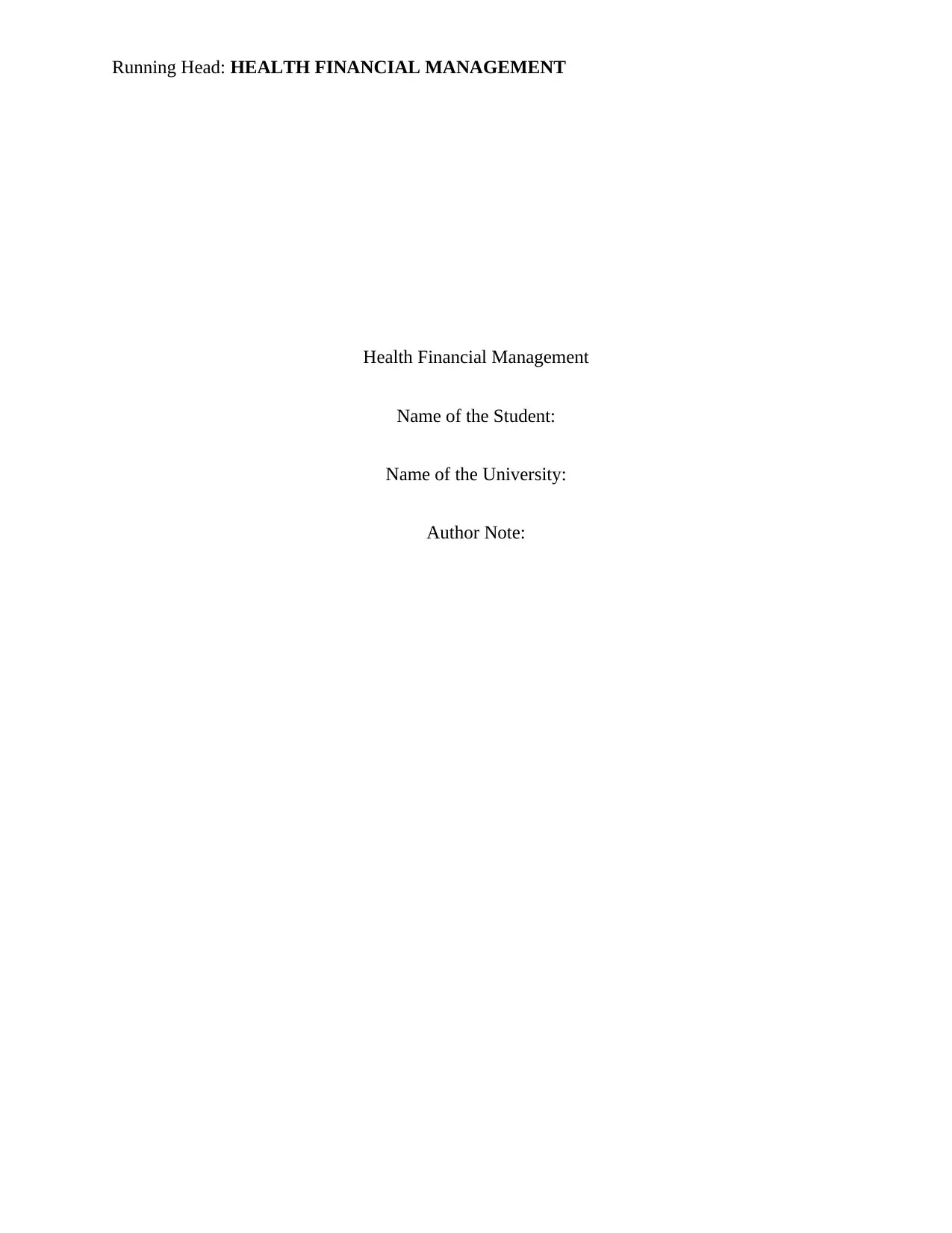
Running Head: HEALTH FINANCIAL MANAGEMENT
Health Financial Management
Name of the Student:
Name of the University:
Author Note:
Health Financial Management
Name of the Student:
Name of the University:
Author Note:
Paraphrase This Document
Need a fresh take? Get an instant paraphrase of this document with our AI Paraphraser
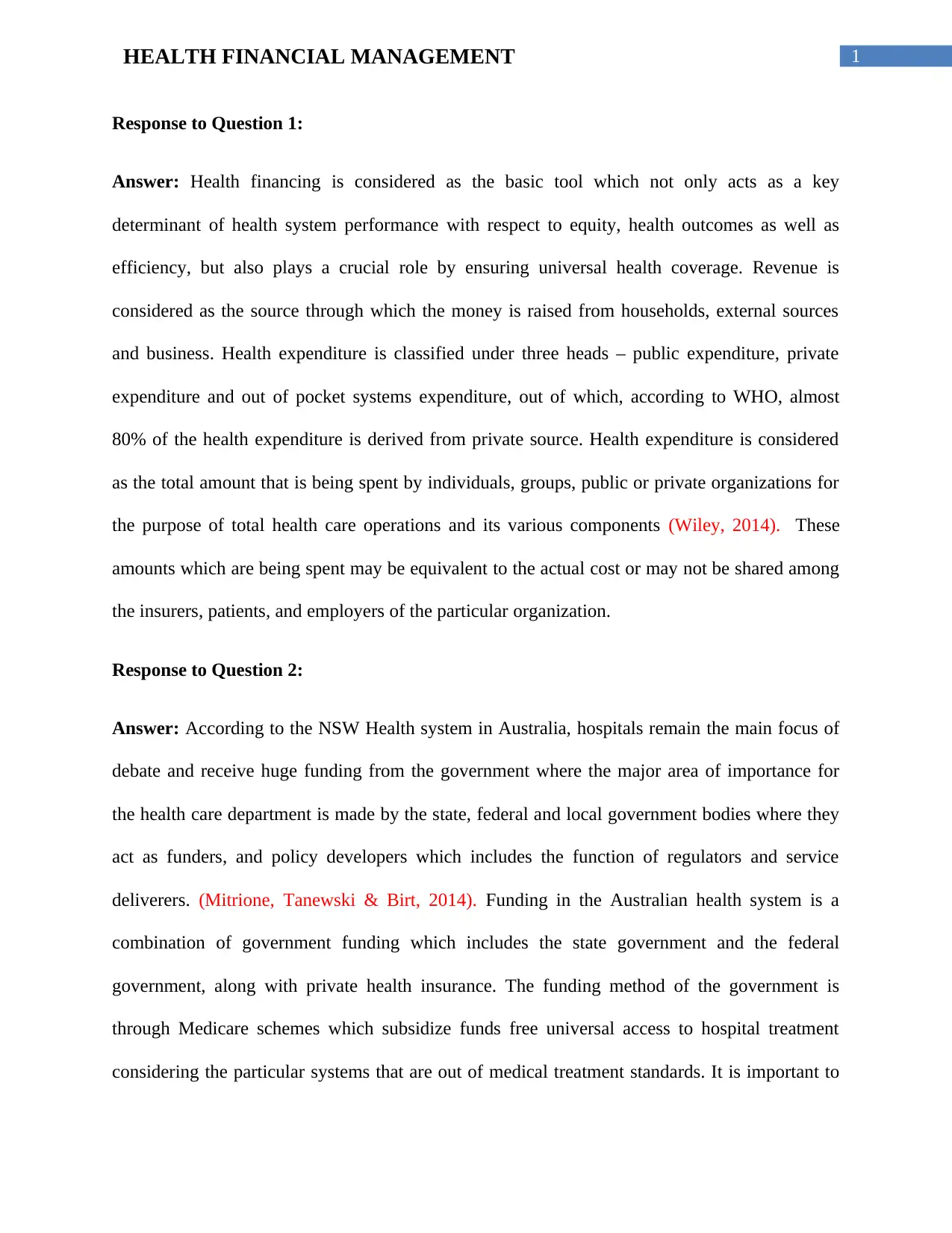
1HEALTH FINANCIAL MANAGEMENT
Response to Question 1:
Answer: Health financing is considered as the basic tool which not only acts as a key
determinant of health system performance with respect to equity, health outcomes as well as
efficiency, but also plays a crucial role by ensuring universal health coverage. Revenue is
considered as the source through which the money is raised from households, external sources
and business. Health expenditure is classified under three heads – public expenditure, private
expenditure and out of pocket systems expenditure, out of which, according to WHO, almost
80% of the health expenditure is derived from private source. Health expenditure is considered
as the total amount that is being spent by individuals, groups, public or private organizations for
the purpose of total health care operations and its various components (Wiley, 2014). These
amounts which are being spent may be equivalent to the actual cost or may not be shared among
the insurers, patients, and employers of the particular organization.
Response to Question 2:
Answer: According to the NSW Health system in Australia, hospitals remain the main focus of
debate and receive huge funding from the government where the major area of importance for
the health care department is made by the state, federal and local government bodies where they
act as funders, and policy developers which includes the function of regulators and service
deliverers. (Mitrione, Tanewski & Birt, 2014). Funding in the Australian health system is a
combination of government funding which includes the state government and the federal
government, along with private health insurance. The funding method of the government is
through Medicare schemes which subsidize funds free universal access to hospital treatment
considering the particular systems that are out of medical treatment standards. It is important to
Response to Question 1:
Answer: Health financing is considered as the basic tool which not only acts as a key
determinant of health system performance with respect to equity, health outcomes as well as
efficiency, but also plays a crucial role by ensuring universal health coverage. Revenue is
considered as the source through which the money is raised from households, external sources
and business. Health expenditure is classified under three heads – public expenditure, private
expenditure and out of pocket systems expenditure, out of which, according to WHO, almost
80% of the health expenditure is derived from private source. Health expenditure is considered
as the total amount that is being spent by individuals, groups, public or private organizations for
the purpose of total health care operations and its various components (Wiley, 2014). These
amounts which are being spent may be equivalent to the actual cost or may not be shared among
the insurers, patients, and employers of the particular organization.
Response to Question 2:
Answer: According to the NSW Health system in Australia, hospitals remain the main focus of
debate and receive huge funding from the government where the major area of importance for
the health care department is made by the state, federal and local government bodies where they
act as funders, and policy developers which includes the function of regulators and service
deliverers. (Mitrione, Tanewski & Birt, 2014). Funding in the Australian health system is a
combination of government funding which includes the state government and the federal
government, along with private health insurance. The funding method of the government is
through Medicare schemes which subsidize funds free universal access to hospital treatment
considering the particular systems that are out of medical treatment standards. It is important to
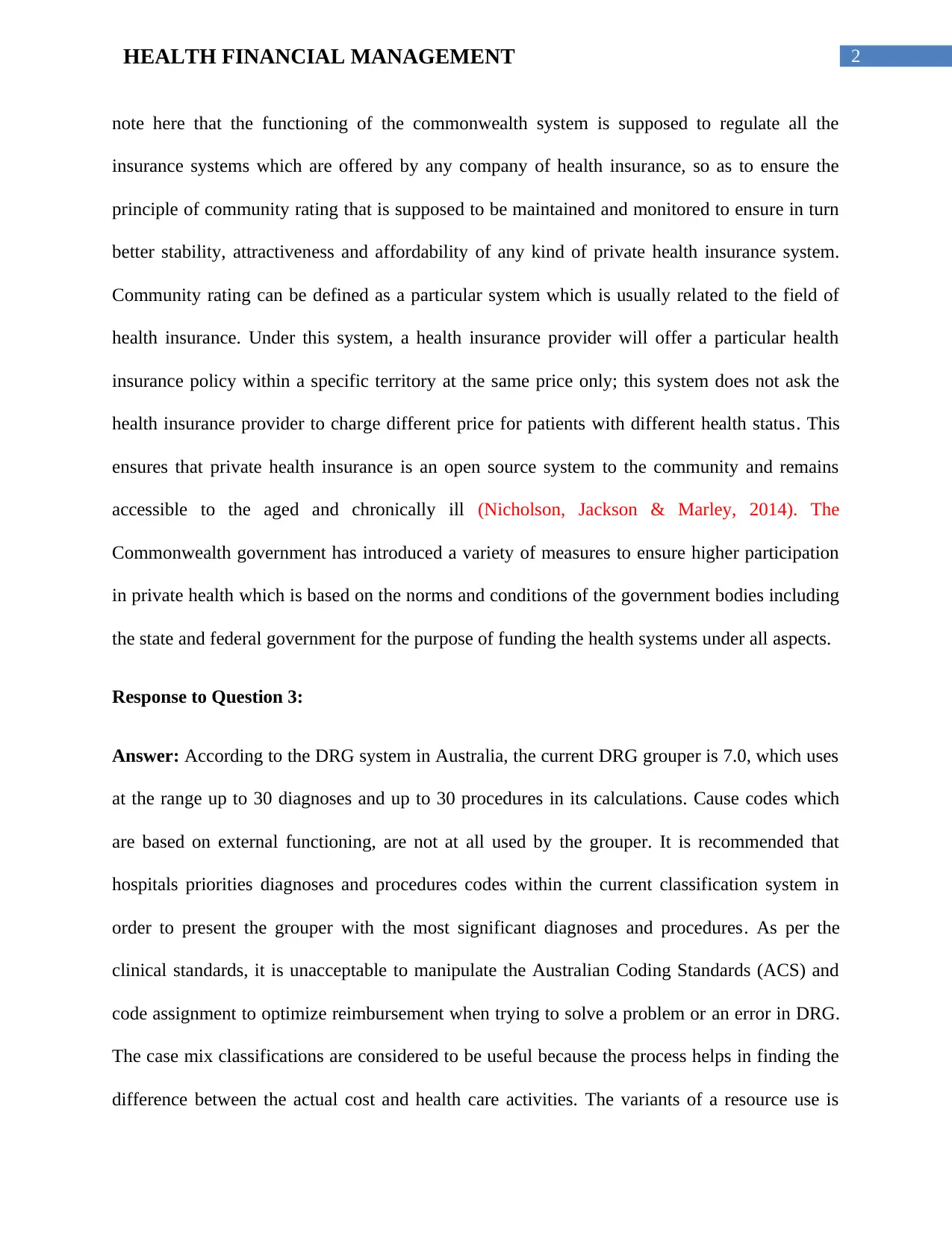
2HEALTH FINANCIAL MANAGEMENT
note here that the functioning of the commonwealth system is supposed to regulate all the
insurance systems which are offered by any company of health insurance, so as to ensure the
principle of community rating that is supposed to be maintained and monitored to ensure in turn
better stability, attractiveness and affordability of any kind of private health insurance system.
Community rating can be defined as a particular system which is usually related to the field of
health insurance. Under this system, a health insurance provider will offer a particular health
insurance policy within a specific territory at the same price only; this system does not ask the
health insurance provider to charge different price for patients with different health status. This
ensures that private health insurance is an open source system to the community and remains
accessible to the aged and chronically ill (Nicholson, Jackson & Marley, 2014). The
Commonwealth government has introduced a variety of measures to ensure higher participation
in private health which is based on the norms and conditions of the government bodies including
the state and federal government for the purpose of funding the health systems under all aspects.
Response to Question 3:
Answer: According to the DRG system in Australia, the current DRG grouper is 7.0, which uses
at the range up to 30 diagnoses and up to 30 procedures in its calculations. Cause codes which
are based on external functioning, are not at all used by the grouper. It is recommended that
hospitals priorities diagnoses and procedures codes within the current classification system in
order to present the grouper with the most significant diagnoses and procedures. As per the
clinical standards, it is unacceptable to manipulate the Australian Coding Standards (ACS) and
code assignment to optimize reimbursement when trying to solve a problem or an error in DRG.
The case mix classifications are considered to be useful because the process helps in finding the
difference between the actual cost and health care activities. The variants of a resource use is
note here that the functioning of the commonwealth system is supposed to regulate all the
insurance systems which are offered by any company of health insurance, so as to ensure the
principle of community rating that is supposed to be maintained and monitored to ensure in turn
better stability, attractiveness and affordability of any kind of private health insurance system.
Community rating can be defined as a particular system which is usually related to the field of
health insurance. Under this system, a health insurance provider will offer a particular health
insurance policy within a specific territory at the same price only; this system does not ask the
health insurance provider to charge different price for patients with different health status. This
ensures that private health insurance is an open source system to the community and remains
accessible to the aged and chronically ill (Nicholson, Jackson & Marley, 2014). The
Commonwealth government has introduced a variety of measures to ensure higher participation
in private health which is based on the norms and conditions of the government bodies including
the state and federal government for the purpose of funding the health systems under all aspects.
Response to Question 3:
Answer: According to the DRG system in Australia, the current DRG grouper is 7.0, which uses
at the range up to 30 diagnoses and up to 30 procedures in its calculations. Cause codes which
are based on external functioning, are not at all used by the grouper. It is recommended that
hospitals priorities diagnoses and procedures codes within the current classification system in
order to present the grouper with the most significant diagnoses and procedures. As per the
clinical standards, it is unacceptable to manipulate the Australian Coding Standards (ACS) and
code assignment to optimize reimbursement when trying to solve a problem or an error in DRG.
The case mix classifications are considered to be useful because the process helps in finding the
difference between the actual cost and health care activities. The variants of a resource use is
⊘ This is a preview!⊘
Do you want full access?
Subscribe today to unlock all pages.

Trusted by 1+ million students worldwide
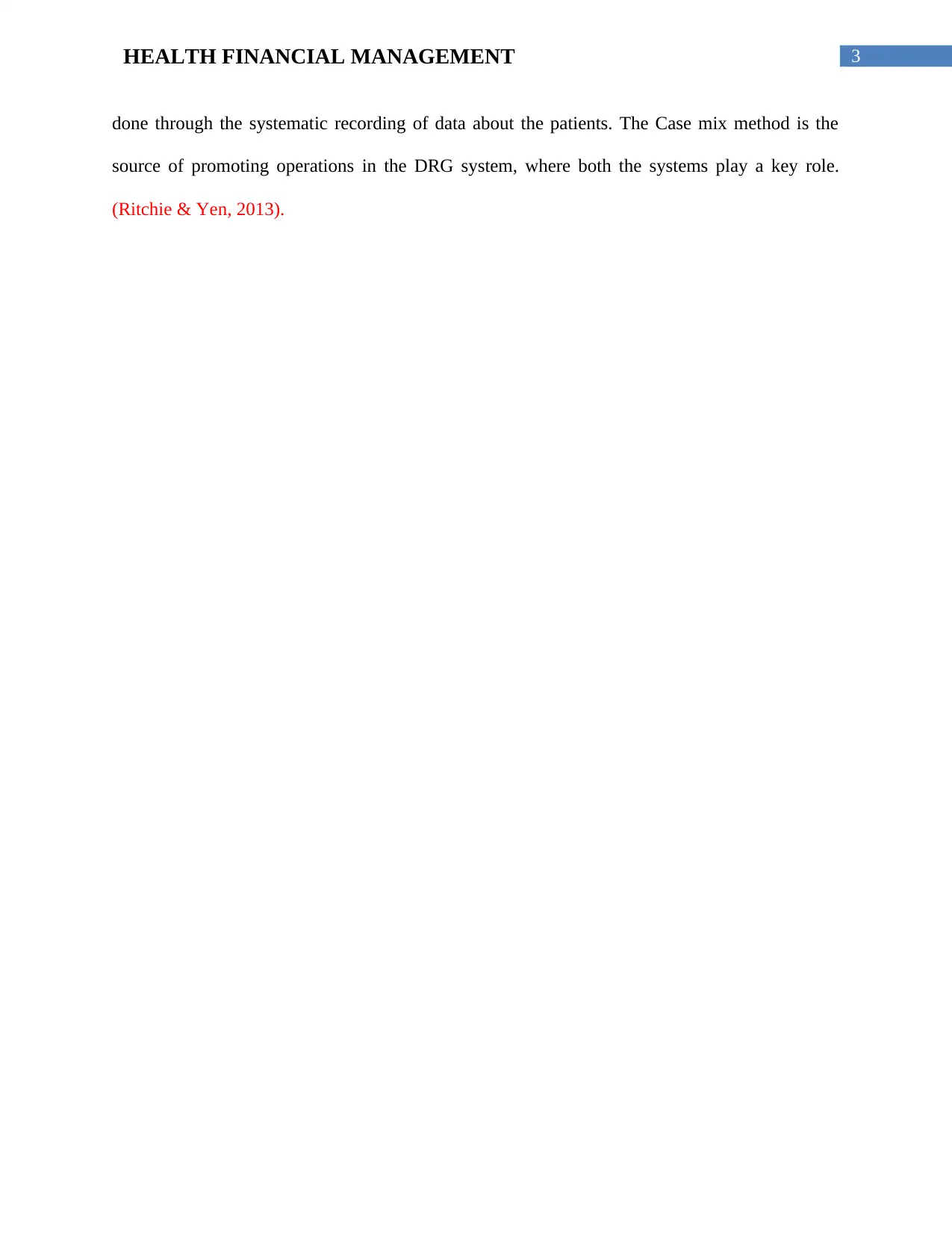
3HEALTH FINANCIAL MANAGEMENT
done through the systematic recording of data about the patients. The Case mix method is the
source of promoting operations in the DRG system, where both the systems play a key role.
(Ritchie & Yen, 2013).
done through the systematic recording of data about the patients. The Case mix method is the
source of promoting operations in the DRG system, where both the systems play a key role.
(Ritchie & Yen, 2013).
Paraphrase This Document
Need a fresh take? Get an instant paraphrase of this document with our AI Paraphraser
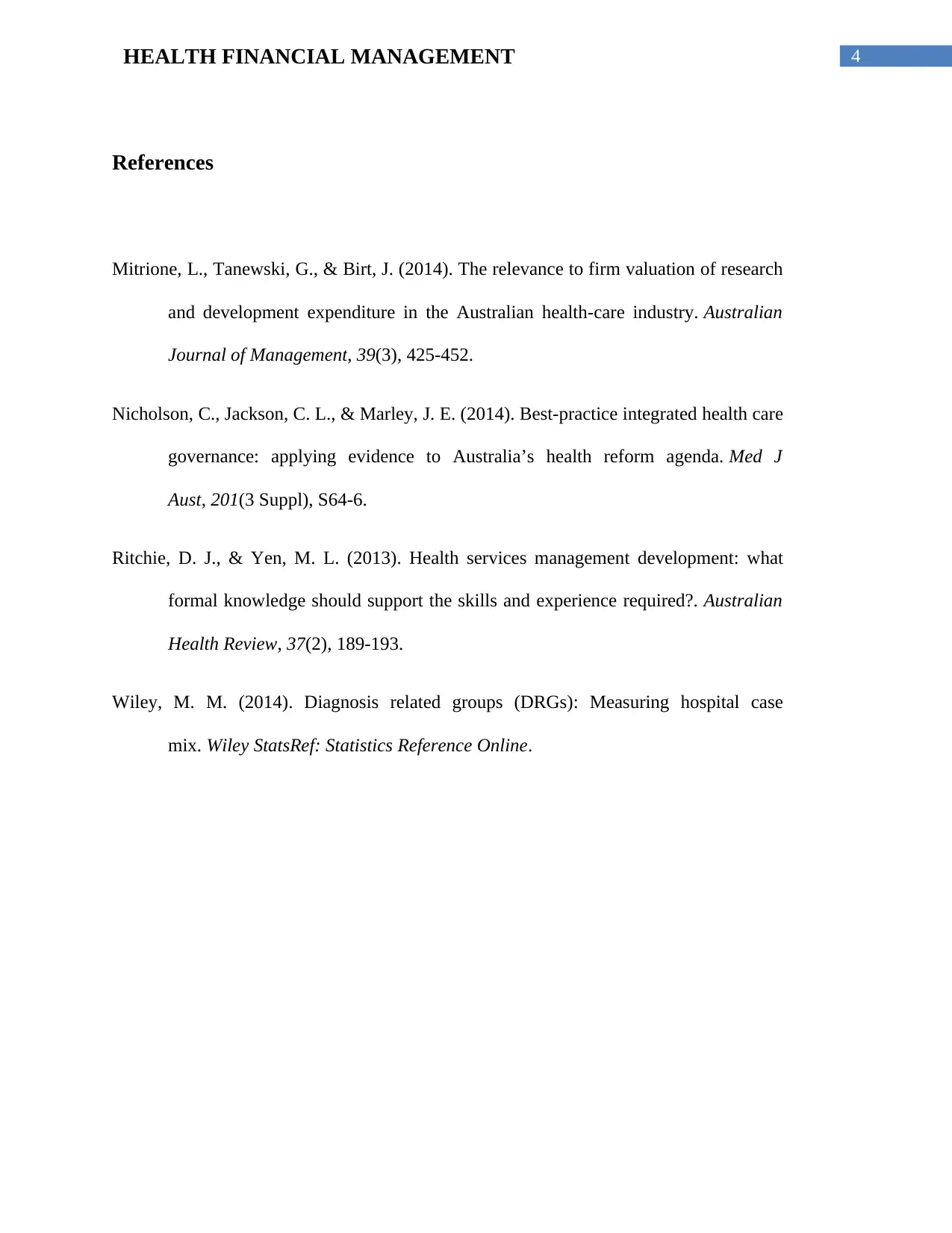
4HEALTH FINANCIAL MANAGEMENT
References
Mitrione, L., Tanewski, G., & Birt, J. (2014). The relevance to firm valuation of research
and development expenditure in the Australian health-care industry. Australian
Journal of Management, 39(3), 425-452.
Nicholson, C., Jackson, C. L., & Marley, J. E. (2014). Best-practice integrated health care
governance: applying evidence to Australia’s health reform agenda. Med J
Aust, 201(3 Suppl), S64-6.
Ritchie, D. J., & Yen, M. L. (2013). Health services management development: what
formal knowledge should support the skills and experience required?. Australian
Health Review, 37(2), 189-193.
Wiley, M. M. (2014). Diagnosis related groups (DRGs): Measuring hospital case
mix. Wiley StatsRef: Statistics Reference Online.
References
Mitrione, L., Tanewski, G., & Birt, J. (2014). The relevance to firm valuation of research
and development expenditure in the Australian health-care industry. Australian
Journal of Management, 39(3), 425-452.
Nicholson, C., Jackson, C. L., & Marley, J. E. (2014). Best-practice integrated health care
governance: applying evidence to Australia’s health reform agenda. Med J
Aust, 201(3 Suppl), S64-6.
Ritchie, D. J., & Yen, M. L. (2013). Health services management development: what
formal knowledge should support the skills and experience required?. Australian
Health Review, 37(2), 189-193.
Wiley, M. M. (2014). Diagnosis related groups (DRGs): Measuring hospital case
mix. Wiley StatsRef: Statistics Reference Online.
1 out of 5
Related Documents
Your All-in-One AI-Powered Toolkit for Academic Success.
+13062052269
info@desklib.com
Available 24*7 on WhatsApp / Email
![[object Object]](/_next/static/media/star-bottom.7253800d.svg)
Unlock your academic potential
Copyright © 2020–2025 A2Z Services. All Rights Reserved. Developed and managed by ZUCOL.





